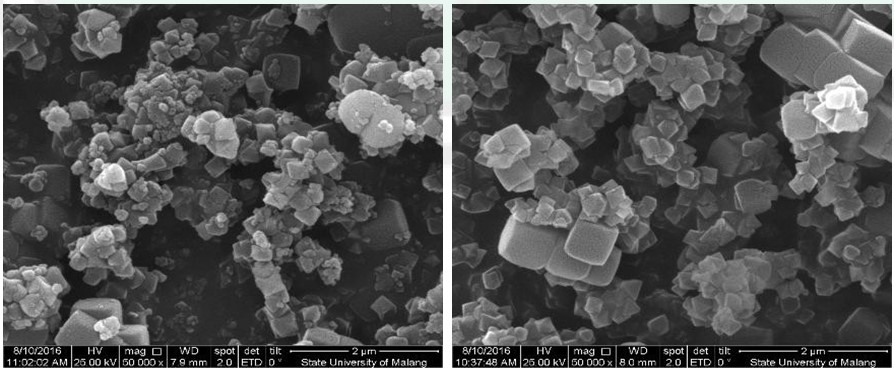Stabilization of Sandy Soil with High Salinity Conditions using Rice Husk Ash and Gypsum to Improve Physical and Mechanical Properties
Main Article Content
Abstract
Sandy soil is a non-cohesive type with no binding force among particles. Non-cohesive soils have loose grains and are not solid. In high-water level conditions, the sandy soil changes its properties to liquid, causing the cohesion value between grains and its shear strength to be lost. This condition can damage civil structures, such as collapse and construction failure. Therefore, soil improvement is carried out by adding rice husk ash and gypsum, which contain SiO2 and CaSO4.2H2O, to bind sand grains. Soil samples were tested by comparing the magnitudes of the cohesion values and the internal shear angles through direct shear tests. The mixing percentages for rice husk ash were 5%, 10%, and 15%, and for adding gypsum was 5%, with curing times of 3 days, 7 days, and 14 days (about 2 weeks). The soil sample used was sandy soil from Congot Beach, Yogyakarta, which has poorly graded sand. The optimal content for improving sandy soil was to use 5% gypsum and add 10% rice husk ash, which was proven to increase the carrying capacity of the soil. This improvement was evidenced by an increase in cohesion from the initial value of 0.029 to 0.061 and a change in shear angle from 19.82° to 29.18° in the sample taken after 14 days (about 2 weeks). The bonding observed due to stabilization was confirmed using the results of X-ray diffraction (XRD) and scanning electron microscopy (SEM).
Article Details

This work is licensed under a Creative Commons Attribution-NonCommercial-NoDerivatives 4.0 International License.
References
Mizan, M. H. Study on the behavior of soft soil reinforced with rice husk ash Study on the behavior of soft soil reinforced with rice husk ash. 2020. no. July 2016, pp. 3-8.
Ahmad, D. The Characteristics and Engineering Properties of Soft Soil at Cyberjaya c ::: J, no. November 2015, 2010.
Ma'Ruf, M. A.; Yulianto, F. E.; Wardani, M. K.; Iswinarti.; Firmansyah, Y. K. Utilization of Lime and Rice Husk Ash for Peat Soil Stabilization in Different Water Content Condition. IOP Conf. Ser. Earth Environ. Sci. 2022. 999(1). https://doi.org/10.1088/1755-1315/999/1/012028
Muntohar, A. S.; Widianti, A.; Hartono,E.; Diana, W. Engineering Properties of Silty Soil Stabilized with Lime and Rice Husk Ash and Reinforced with Waste Plastic Fiber, J. Mater. Civ. Eng. 2013, 25(9), 1260-1270, https://doi.org/10.1061/(ASCE)MT.1943-5533.0000659
Nugroho, S. A.; Fatnanta, F.; Ongko, A.; Ihsan, A. R. Behavior of High-plasticity Clay Stabilized with Lime and Rice Husk Ash. Makara J. Technol. 2021. 25(3). https://doi.org/10.7454/mst.v25i3.3580
Rahil, F. H.; Al-Soudany, K. Y. H.; Abbas, N. S.; Hussein, L. Y. Geotechnical Properties of Clayey Soils Induced by the Presence of Sodium Chloride. IOP Conf. Ser. Mater. Sci. Eng. 2019, 518(2). https://doi.org/10.1088/1757-899X/518/2/022064
Wibowo, D. E.; Ramadhan, D. A.; Endaryanta.; Prayuda, H. Soil stabilization using rice husk ash and cement for pavement subgrade materials. Rev. la Constr. 2023, 22(1), 192-202 https://doi.org/10.7764/RDLC.22.1.192
Qasim, M.; Bashir, A.; Tanvir, M.; Anees, M. M. Effect of Rice husk on soil stabilization. Bull. Energy Econ. 2015, 3(1), 10-17, [Online]. Available: http://www.tesdo.org/JournalDetail.aspx?Id=4
Adedeji. Soil stabilization using rice husk ash. Intech. 2016, i, no. tourism, 13. [Online]. Available: https://www.intechopen.com/books/advanced-biometric-technologies/liveness-detection-in-biometrics
Kumar, B. S.; Preethi, T. V. Behavior of Clayey Soil Stabilized with Rice Husk Ash & Lime. Int. J. Eng. Trends Technol. 2014, 11(1), 44-48. https://doi.org/10.14445/22315381/IJETT-V11P209
Pham, V. P.; Tran, V. T. Rice Husk Ash Burnt in Simple Conditions for Soil Stabilization. Lect. Notes Civ. Eng. 2020, 62, 717-721. https://doi.org/10.1007/978-981-15-2184-3_93
Al-azzawi, A. A. Effect of Silica Fume Addition on the Behavior of Silty-Clayey Soils. J. Eng. Dev. 2012, 16(1), 92-105.
Adefemi, B. A.; Olufemi, A. S.; Tajudeen, O. A. Influence of compactive efforts on lateritic soil stabilized with rice husk ash. Int. J. Appl. Eng. Res. 2014, 9(21), 9639-9654.
Alhassan, M.; Mustapha, A. M. Effect of Rice Husk Ash on Cement Stabilized Laterite. Leonardo Electronic Journal of Practices and Technologies 2007, 11, 47-58.
Abdurrozak, M. R.; Mufti, D. N. Stabilisasi Tanah Lempung Dengan Bahan Tambah Abu Sekam Padi Dan Kapur Pada Subgrade Perkerasan Jalan. J. Tek. 2017, XXII(2), 416-424.
Diana, N. A.; Ekaputri, J. J.; Satrya, T. R.; Warnana, D. D. Biocementing Process to Improve the Physical and mechanical properties of saline soils that have the potential for liquefaction. 2024. https://doi.org/10.1063/5.0204850
Adajar, M. A. Q.; Aquino, C. J. P.; dela Cruz, J. D.; Martin, C. P. H.; Urieta, D. K. G. Investigating the effectiveness of rice husk ash as stabilizing agent of expansive soil. Int. J. GEOMATE. 2019, 16(58), 33-40. doi: 10.21660/2019.58.8123 https://doi.org/10.21660/2019.58.8123
Sarapu, D. POTENTIALS OF RICE HUSK ASH FOR SOIL STABILIZATION' Department of Civil Engineering Presented by : Divyateja Sarapu 'POTENTIALS OF RICE HUSK ASH FOR SOIL STABILIZING. 2016.


